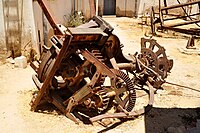Wind engine Otjimbingwe
| Wind engine Otjimbingwe | ||
|---|---|---|
|
National monument in Namibia |
||
| Monument type | Industrial monument | |
| location | Otjimbingwe | |
| Geographic coordinates : | 22 ° 21 ′ 7 ″ S , 16 ° 8 ′ 12 ″ E | |
|
|
||
| Emergence | 1897 | |
|
Recognized by the National Heritage Council |
1963 | |
| Deprivation | ||
| Sponsorship | ||
| Website | NHC Namibia | |
The Otjimbingwe wind engine is an industrial monument - largely destroyed - in the Namibian settlement of Otjimbingwe . The 20 meter high wind turbine consisted of a steel frame, a wooden impeller with a diameter of about ten meters and a long tail unit. The wind engine 1 was located in the back yard of Eduard Hälbich's former wagon construction and generated mechanical energy to drive the machines in the workshop.
history
The tower for the complex was built in 1897 by Gottlieb Redecker on behalf of the Hälbich family. According to the Halladay system, the wind energy converter was from Fried. Filler machine factory in Hamburg was designed and was put into operation on October 7, 1897.
After the end of its use, the wind turbine fell into disrepair. The wooden wheel hadn't been around for a long time and the gearbox had become unusable. On the steel tower there was only the gearbox including the shaft with the tail unit as part of the former wind turbine. The tower structure was still in good condition.
In the 1960s, attempts were made to restore the wind engine and make it functional again, but the costs were too high. The wind engine in Otjimbingwe was added to the list of National Monuments in Namibia on August 15, 1963 .
The restoration efforts came to an abrupt end in 2008, when the tower was razed by looters who were after the scrap value of the scrap iron .
description
The impeller at the top of the steel tower drove a vertical shaft that led to a gearbox below . From the gearbox, the power was transmitted through a drive belt to a horizontal shaft reaching into the workshop building, where it drove a wood and metal lathe, a chainsaw and a drill ( transmission ). The plant also pumped the water for Otjimbingwe from a spring. The wind engine had an output of eight hp (approximately 6 kW ). The system was set up and regulated automatically.
Remarks
Web links
- Photo: former car manufacturer Eduard Hälbich, behind it a wind engine
- historical photos as well as the remains of the wind engine 2014
Individual evidence
- ↑ a b c d Andreas Vogt : National Monuments in Namibia - An inventory of the proclaimed national monuments in the Republic of Namibia (December 14, 2005) Wind power for car manufacturing ( Memento from February 1, 2014 in the Internet Archive ), Allgemeine Zeitung , Windhoek 2005, (accessed December 6, 2009)
- ↑ Fried pump and wind motor factory. Filler , Anzeiger zum Centralblatt der Bauverwaltung , March 18, 1882, p. 8, accessed on December 9, 2012
- ↑ National Monuments in Namibia - An inventory of the proclaimed national monuments in the Republic of Namibia , Andreas Vogt, Gamsberg Macmillan Verlag, Windhoek, 2006
- ↑ Monuments plundered - report in the Allgemeine Zeitung of October 21, 2008

